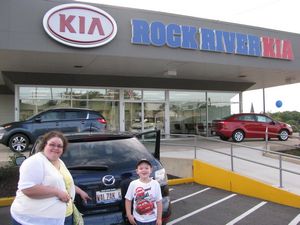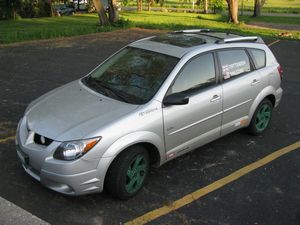|
By accessing or using The Crittenden Automotive Library™/CarsAndRacingStuff.com, you signify your agreement with the Terms of Use on our Legal Information page. Our Privacy Policy is also available there. |

The American Road, Part 1: Introduction
|
|---|
|
|
 Opinions expressed by Bill Crittenden are not official policies or positions of The Crittenden Automotive Library. You can read more about the Library's goals, mission, policies, and operations on the About Us page.
Opinions expressed by Bill Crittenden are not official policies or positions of The Crittenden Automotive Library. You can read more about the Library's goals, mission, policies, and operations on the About Us page.
|
The American Road, Part 1: Introduction
Bill Crittenden
March 19, 2014
 2010 Mazda CX-7 iSport 2010 Mazda CX-7 iSport
 2003 Pontiac Vibe AWD 2003 Pontiac Vibe AWD
|
I've been asked to write a bit about the American driver's perspective. Considering my audience is likely to be mostly British readers, I think I'll introduce this endeavor with a few basics about being on an American road that (based on what I can gather about British road conditions from Top Gear) y'all might not know.
I think the most striking differences center around the basic American attitudes about being free from "government intervention." Our driving tests are notoriously easy among the nations of the developed world, and driving is seen as a God-given right to only be taken away if it can be proven beyond a reasonable doubt that someone is endangering lives. That's still sometimes not enough. So good luck even trying to tell us which lane to drive in!
In Chicago, the large city nearest to where I live, there had been a problem for years (as exposed memorably by the Chicago Sun-Times several years ago) of drivers going to court, having their licenses suspended, and driving home. The penalties for so many offenses are light enough to be absorbed into the general costs of driving almost unnoticed, and even getting behind the wheel after the more heavily penalized drunk driving might result in a slap-on-the-wrist "driving without a license" charge. (
"How drunks keep on driving" at MSN)
They might, or they might not, and that all depends on where the offense occurred. Which brings us to point number 2: the United States functions more like the European Union than a homogenous nation. We are, technically, 50 independent States bound by a common foreign policy and currency. When it comes to local affairs the federal government is supposed to be limited to "regulating inter-State commerce." So what happens within a state is supposed to be regulated only by the state, and so these regulations can differ from one place to the next.
So each state has a different driving test, a different style license, different taxes and costs, and different license plates. In Illinois you need plates front and rear, in Kansas, only on the rear, and occasionally a driver (my brother living in Kansas, for example) will get pulled over for not having a front license plate because suburban Chicago police aren't used to seeing Kansas cars.
So driving from Illinois to Wisconsin can be a bit like, I imagine, driving from Italy to Germany. You cross the border pretty much without fanfare, but suddenly the rules of the road are more strict, the roads themselves smooth out, speed limits come up, local police look upon you (with your car's outsider markings) as though you're an accident looking for a place to happen, and all the local business names suddenly seem to change from Giordano and Lou Malnati to Usinger, Pabst, and Schlitz.
All the states have different penalties for various offenses, different insurance regulations, the list goes on and on. At least a few basics can be agreed upon: green means go and red means stop. Sometimes, that seems about all we can agree upon. Oh, and we all drive on the right side of the road. Lucky for us there isn't one oddball rogue state that insists on doing things differently in this regard...
Since France is just a hop across the Channel away, I'll save you the descriptions of this, but I do have to say that as most people are right-handed, driving seems like it'd be easier from the left side of the car, leaving the dominant right hand free to manipulate the radio, sat nav, and all the other little buttons in the middle of the car. I have trouble changing the radio station from the passenger seat sometime, and I'm not trying to hold a car steady at 60 miles an hour while doing so!
You know what else I can do more easily right handed? Eat a cheeseburger. Perhaps nothing else defines international car culture clash as much as when Porsche began getting popular here, and Americans demanded cupholders in their cars. The German attitude is, "you're driving, what do you need a cupholder for?
Americans?
We're overworked. We take our two weeks' holiday pay as a bonus and work more than 40 hours a week, 52 weeks a year, 8 years in a row (yes, I really did). On top of the time spent actually working we, many of us, spend an hour in the car each morning and each evening, and that's contributed to the bag of "McFood" becoming a symbol of America. It's not because we're "lovin' it," as McDonald's asserts, but because we can be in, out, and back on the road in 3 minutes with one of the foods easiest to eat one-handed while behind the wheel.
The American driving attitude can be nicely summed up by Henry Ford II when he said: "Americans like to blast along over interstate highways at eighty miles an hour in big cars with every kind of power attachment, windows up, air conditioning on, radio going, one finger on the wheel. That's what they want, and that's what they buy, and that's what we manufacture. We build the best cars we can to meet the taste of the American people." Perhaps he would have mentioned McDonald's had drive-thru fast food been popular during his era.
However, the quote from Mr. Ford II, particularly the last sentence, leads me to the another important general point about being an American driver that people from overseas don't see from their perspective: our cars are actually pretty damn good.
We all know that Japanese cars are, for the most part, built for handling and efficiency, as would be expected of a tiny, crowded archipelago that has to import all its own fuel. I remember a story from a documentary that a Nissan executive, at the very beginning of their foray into the American market in 1960, took the little Datsun they were selling onto an American highway, and immediately got right the hell back off, fearing for his life as the tiny underpowered car couldn't keep up with the huge chrome behemoths charging past. This would lead to a huge change in the way Nissan made cars for the American market.
So as ridiculous as big, soft-handling American cars and pickup trucks might seem in London or the back roads of the English countryside, they are well suited to our roads and conditions. Consider what we drive them on: mile upon mile of wide, straight line, cheaply built, potholed asphalt where it's a good thing gas is cheap because we sure do burn enough of it sitting in traffic, often on a cold morning in a car that's as gray as the sky regardless of how the factory painted it because it's coated in road salt.
As nice as a Mercedes does on track tests and car reviews based on pleasant backwoods driving, I'd rather have the overly plush Buick that costs half as much (aside from the salt corrosion, the cars do get dinged up a bit in parking lots, too) to take me into this kind of battle. My wife's Mazda CX-7 can be quite painful on a half-full bladder when the roads here buckle on the subzero winter days, and it's times like that I wish we had gotten a Buick Century instead.
But then this reminds me of my final, very important part of driving in America: I'm from almost-rural Illinois, near Chicago, and I've driven in just 4 cold-winter states my adult life. It's a big damn country, from the beaches of Florida up through the backwoods of Georgia, up the coast to the glittering lights of New York City, across worn, forested mountains, past steel mills, through coal country, then across vast plains of pickup-truck dotted farmland to the craggy peaks of the Rockies, down to the deserts of Arizona and New Mexico, to the sunny west coast of California, up the other coast to the rainy Pacific Northwest. We're a country big enough and diverse enough to have NASCAR and lowriders, off-roading and Indianapolis, JDM imports and classic American hot rods.
Even driving from my hometown in the middle of northwestern suburban Chicago to where I live now at the edge of vast farm fields, what is at the beginning of the journey a sea of import crossovers in shopping mall lots slowly gives way in just an hour and a half's time to roadways and hardware store parking lots filled more and more with pickup trucks, American SUVs, and old Pontiac sedans.
So here I'll be working with Geoff, sharing for the rest of the world a little American perspective beyond the usual "measuring one's gentleman parts in cubic inches" that is the stereotypical American car guy's point of view.
If you have any questions or suggestions for topics, e-mail me at admin@carsandracingstuff.com!

















 Opinions expressed by Bill Crittenden are not official policies or positions of The Crittenden Automotive Library. You can read more about the Library's goals, mission, policies, and operations on the About Us page.
Opinions expressed by Bill Crittenden are not official policies or positions of The Crittenden Automotive Library. You can read more about the Library's goals, mission, policies, and operations on the About Us page.
 2010 Mazda CX-7 iSport
2010 Mazda CX-7 iSport
 2003 Pontiac Vibe AWD
2003 Pontiac Vibe AWD
